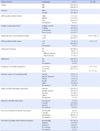Abstract
Purpose
This study was conducted to analyze the association between health literacy and health behavior and the effect of health literacy on health behavior in late school-age children.
Methods
Data were obtained from 333 participants who were 5th and 6th-grade students sampled from 8 elementary schools in Busan. Rapid Estimate of Adolescent Literacy in Medicine (REALM-Teen) and Newest Vital Sign (NVS) was used for assessing linguistic and functional health literacy, and the health promotion behavior score was measured for health behavior.
Results
The percentage of those with limited linguistic and functional health literacy was high (47.1%, 56.8%). Linguistic health literacy (r=.38, p<.001) and functional health literacy (r=.11, p=.048) had a correlation with health behavior. Health behavior was significantly associated with perceived health status (β=1.94, p<.001), number of times of health education (β=0.18, p<.001), academic achievement (p<.001), home literacy environment (β=0.13, p=.016), perception of changes after health education (p=.011), and linguistic health literacy (β=0.23, p<.001).
Conclusion
The results of this study indicate that children with adequate health literacy are more likely to do health behaviors. Therefore, it is important to develop educational strategies to raise children's health literacy level and consequently to induce them to perform more health behaviors in daily life.
Figures and Tables
Table 1
Characteristics of the Participants (N=333)

Table 2
Health behavior Score and Health Literacy (N=333)

Table 3
Differences in Health Literacy and Health Behavior Score according to Characteristics (N=333)

Table 4
Correlation among Health Literacy and Health Behavior

Table 5
Hierarchical Multiple Linear Regression of Health Literacy on Health Behavior

References
1. Shin MH, Seo EH, Song SG, Kim EK, Won YS, Noh WG, et al. Developmental psychology. Seoul: Hakjisa;2013. p. 182.
2. Farrand LL, Cox CL. Determinants of positive health behavior in middle childhood. Nurs Res. 1993; 42(4):208–213.

3. World Health Organization. Report No. 870. Promoting health through schools. Geneva: World Health Organization;1997. 09.
4. Kim SH, Lee JH. Test of a hypothetical model for health promoting behavior in school-aged children. J Korean Acad Child Health Nurs. 2008; 14(1):22–34.
5. Institute of Medicine. Health literacy: A prescription to end confusion. Washington DC: National Academy Press;2004. p. 41.
6. Nutbeam D. Literacies across the lifespan: Health literacy. Lit Numeracy Stud. 1999; 9(2):47–55.
7. von Wagner C, Steptoe A, Wolf MS, Wardle J. Health literacy and health actions: A review and a framework from health psychology. Health Educ Behav. 2009; 36(5):860–877. DOI: 10.1177/1090198108322819.

8. Dewalt DA, Berkman ND, Sheridan S, Lohr KN, Pignone MP. Literacy and health outcomes. J Gen Intern Med. 2004; 19(12):1228–1239. DOI: 10.1111/j.1525-1497.2004.40153.x.

9. DeWalt DA, Hink A. Health literacy and child health outcomes: A systematic review of the literature. Pediatrics. 2009; 124(3):S265–S274. DOI: 10.1542/peds.2009-1162B.

11. Davis TC, Crouch MA, Long SW, Jackson RH, Bates P, George RB, et al. Rapid assessment of literacy levels of adult primary care patients. Fam Med. 1991; 23(6):433–435.
12. Lee TW, Kang SJ. Health literacy in the Korean elderly and influencing factors. J Korean Gerontol Soc. 2008; 28(4):847–863.
13. Lee SH, Choi EHR, Je MJ. Comparison of two versions of KHLAT for improvement strategies. Korean J Health Educ Promot. 2011; 28(3):57–65.
14. Ahn EJ, Kwon IS. Health literacy of elementary school students. Child Health Nurs Res. 2014; 20(4):322–331. DOI: 10.4094/chnr.2014.20.4.322.

15. Sanders LM, Zacur G, Haecker T, Klass P. Number of children's books in the home: An indicator of parent health literacy. Ambul Pediatr. 2004; 4(5):424–428.

16. Driessnack M, Chung S, Perkhounkova E, Hein M. Using the "newest vital sign" to assess health literacy in children. J Pediatr Health Care. 2014; 28(2):165–171. DOI: 10.1016/j.pedhc.2013.05.005.

18. Davis TC, Wolf MS, Arnold CL, Byrd RS, Long SW, Springer T, et al. Development and validation of the Rapid Estimate of Adolescent Literacy in Medicine (REALM-Teen): A tool to screen adolescents for below-grade reading in health care settings. Pediatrics. 2006; 118(6):e1707–e1714.

19. Weiss BD, Mays MZ, Martz W, Castro KM, DeWalt DA, Pignone MP, et al. Quick assessment of literacy in primary care: The newest vital sign. Ann Fam Med. 2005; 3(6):514–522.

20. Richard CH. Newest vital sign toolkit [Internet]. NY: Pfizer Inc;2011. cited 2015 January 15. Available from: http://www.pfizer.com/files/health/nvs_flipbook_english_final.pdf.
21. Pender NJ, Pender AR. Illness prevention and health promotion services provided by nurse practitioners: Predicting potential consumers. Am J Public Health. 1980; 70(8):798–803.

22. Walker SN, Sechrist KR, Pender NJ. The health-promoting lifestyle profile: development and psychometric characteristics. Nurs Res. 1987; 36(2):76–81.
23. Kim HS, Kim YI. Factors related to health promoting behavior in late school-age Children. J Korean Soc Sch Health. 2010; 23(1):1–10.
24. Nah JY, Kim YI, Kim HS. The effects of systematic health education on health knowledge and health promotion behavior in elementary school students. J Korean Soc Sch Health. 2011; 24(2):173–180.
25. Chang LC. Health literacy, self-reported status and health promoting behaviours for adolescents in Taiwan. J Clin Nurs. 2011; 20(1/2):190–196.

26. Schmidt CO, Fahland RA, Franze M, Splieth C, Thyrian JR, Plachta-Danielzik S, et al. Health-related behaviour, knowledge, attitudes, communication and social status in school children in Eastern Germany. Health Educ Res. 2010; 25(4):542–551. DOI: 10.1093/her/cyq011.

27. Brown SL, Teufel JA, Birch DA. Early adolescents perceptions of health and health literacy. J Sch Health. 2007; 77(1):7–15. DOI: 10.1111/j.1746-1561.2007.00156.x.

28. Zullig KJ, Ubbes VA, Mann M. Early adolescent literacy influences, reading ability, and preventative health behaviors. Am J Health Stud. 2013; 28(3):134–141.
29. Borzekowski DL. Considering children and health literacy: A theoretical approach. Pediatrics. 2009; 124(3):S282–S288. DOI: 10.1542/peds.2009-1162D.

30. Joint Committee on National Health Education Standards. Achieving health literacy: An investment in the future. Atlanta, GA: American Cancer Society;1995. p. 88.




 PDF
PDF ePub
ePub Citation
Citation Print
Print


 XML Download
XML Download